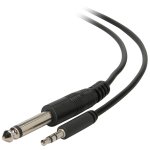You don't have to be condescending.
I'm really not looking to do any soldering and whatnot. Just looking for a simple $10 solution somewhere.
No 10$ solution, you'll have to solder.
If you want to solve your problem, that's the way.
If you can't , have a Tech anywhere do it for you, but I respectfully suggest you get the basic tools and practice, because it will be a very useful skill for you.
As of the cable, all you need is a proper end to end length XLR to "nothing/XLR" mic cable and a good 1/8" MONO plug .
Big problem which complicates your life is that in the Guitar World XLR to Mono plug cables are available , in fact some cheap mikes come that way from factory, to be able to plug them straight into Guitar type amps, old PA heads, etc. which universally come with Mono jacks ... problem is they are 1/4" , not 1/8" .
And the Pro world uses XLR balanced , there's not such thing as a officially recognized thing as XLR unbalanced; and the Hi Fi world thinks Stereo, so 1/4"to 1/8" adapters are Stereo (what you already have) .
So looking for an off the shelf solution is not easy. Different worlds.
I suggest getting an unterminated (1 free end) XLR cable or a terminated one but you nip off the male end , you strip and twist tofether screen and cold wire (the ones which originally went to pins 1 and 3) , that's your ground, and the Hot wire, the one which went to pin 2, now is your new unbalanced hot.
Solder them to a good 1/8" MONO plug.
Wire will be way too thick, in fact thicker than the screw on cap, so junk it, cover the soldering with 5 minute Epoxy or hot glue and cover that with heat shrink tube.
This will work 1000 times better than a chain of flimsy cheap adapters.
2 extra suggestions:
1) make 2 such cables, just in case
2) tie/wrap/glue/tape that cable somewhere close to the camera or notebook, you don't want some moron tripping on the cable and cracking the jack, dropping the expensive camera or NB into the floor, etc.
Why do I say so?
 .... think ...... 🙁
.... think ...... 🙁
Last edited:
sorry JM close but no cigar unbalancing the mic with the cable connections you described still doesn't solve him applying that to the "tip" and "ring" of the 1/8 (left right input of his recording device)
to you and i the solution is simple get a "handy box" mount the appropriate jacks and maybe a matching transformer for good measure a quick bit of soldering(i love the smell of rosin core in the morning) and call it a day but ...
to you and i the solution is simple get a "handy box" mount the appropriate jacks and maybe a matching transformer for good measure a quick bit of soldering(i love the smell of rosin core in the morning) and call it a day but ...
Thanks for all the replies, I'm doing my best to understand it all. I would really appreciate, however, if maybe someone could post a link to an actual product, as I am having a hard time shopping using the above advice.
To put it simply, I need to plug a mono XLR mic into a stereo mini jack. I don't want "doubled" identical signals in each channel witch is what I'm getting now. Maybe someone could give a link to any cables or adapters that would get the job done.
Again, you guys are awesome for all the recommendations.
To put it simply, I need to plug a mono XLR mic into a stereo mini jack. I don't want "doubled" identical signals in each channel witch is what I'm getting now. Maybe someone could give a link to any cables or adapters that would get the job done.
Again, you guys are awesome for all the recommendations.
ART Tube MP Studio Mic Preamp https://www.amazon.com/dp/B0002E50MC/ref=cm_sw_r_awd_FHuzub188D7A9
this and a XLR to XLR, then a TS to TS 1/4" to 1/8".
this and a XLR to XLR, then a TS to TS 1/4" to 1/8".
Let me try
No, the problem is there are no left and right channels coming out the microphone. Your computer has left and right INPUTS, but those are expecting different signals. The two live pins on the microphone are just opposite ends of the same mic element. The mic element makes a small voltage output from sound that hits it, but that voltage is across those two hot pins, NOT from either pin to ground. The ONLY thing the ground pin of the mic does is connect to the cable shield, it has zero to do with the signal. The ground also completes the path on phantom powered mics, but that is a whole separate topic. The mic is thus mono. As was explained earlier balanced and stereo are not the same thing, though the hifi world and the audio worlds may overlap some on that.
A headphone plug might be called "stereo" but that is only because it is used for that purpose in the phones. It is a TRS plug, one form of a balanced connector.
Your mic makes one balanced output signal. YOu can send that to a balanced input somewhere. Or convert it to unbalanced with a matching transformer. The computer 1/8" jack has left and right connections. It is stereo, but not balanced.
On the mic pins 2 and 3 are "hot", and one end has the reverse polarity from the other. SOMETIMES you can cheat and ground pin 2 OR 3 to pin 1 And use the remaining pin as hot and run THAT into an unbalanced jack. That isn;t best, but might work well enough for you. But since your input is stereo to the computer, then you either need to adapt the computer to mono and feed the mic to both, or accept that your mic will only come into one of the L or R channels.
This thing converts your mic to unbalanced:
http://www.amazon.com/s/ref=nb_sb_noss?url=search-alias=mi&field-keywords=mic impedance adaptor
You can stick it right into the mic and use a 1/4" cable or (better) run a regular XLR-XLR cord from the mic down to the adaptor.
Now you have a plain old 1/4" mono unbalanced mic signal.
Oh, and there are actually converter cables with the transformer hidden inside, XLR on one end and 1/4 male on the other.
I know there are basic adaptors that convert 1/4" to 1/8", and I know there are those that convert stereo to mono. In your case, an adaptor with 1/8 male stereo down to 1/4" female mono finishes it. I don;t like setups with adaptors plugged into adaptors, but there you go.
So here's the problem. Both the left and right channels coming out are identical. This results in phased silence when it's plugged into my laptop (because the DAC I use converts stereo inputs to mono), and audible unbalanced stereo when using my camcorder, which just sounds weird.
No, the problem is there are no left and right channels coming out the microphone. Your computer has left and right INPUTS, but those are expecting different signals. The two live pins on the microphone are just opposite ends of the same mic element. The mic element makes a small voltage output from sound that hits it, but that voltage is across those two hot pins, NOT from either pin to ground. The ONLY thing the ground pin of the mic does is connect to the cable shield, it has zero to do with the signal. The ground also completes the path on phantom powered mics, but that is a whole separate topic. The mic is thus mono. As was explained earlier balanced and stereo are not the same thing, though the hifi world and the audio worlds may overlap some on that.
A headphone plug might be called "stereo" but that is only because it is used for that purpose in the phones. It is a TRS plug, one form of a balanced connector.
Your mic makes one balanced output signal. YOu can send that to a balanced input somewhere. Or convert it to unbalanced with a matching transformer. The computer 1/8" jack has left and right connections. It is stereo, but not balanced.
On the mic pins 2 and 3 are "hot", and one end has the reverse polarity from the other. SOMETIMES you can cheat and ground pin 2 OR 3 to pin 1 And use the remaining pin as hot and run THAT into an unbalanced jack. That isn;t best, but might work well enough for you. But since your input is stereo to the computer, then you either need to adapt the computer to mono and feed the mic to both, or accept that your mic will only come into one of the L or R channels.
This thing converts your mic to unbalanced:
http://www.amazon.com/s/ref=nb_sb_noss?url=search-alias=mi&field-keywords=mic impedance adaptor
You can stick it right into the mic and use a 1/4" cable or (better) run a regular XLR-XLR cord from the mic down to the adaptor.
Now you have a plain old 1/4" mono unbalanced mic signal.
Oh, and there are actually converter cables with the transformer hidden inside, XLR on one end and 1/4 male on the other.
I know there are basic adaptors that convert 1/4" to 1/8", and I know there are those that convert stereo to mono. In your case, an adaptor with 1/8 male stereo down to 1/4" female mono finishes it. I don;t like setups with adaptors plugged into adaptors, but there you go.
Hi,
Your problem is your adaptor, which is balanced to balanced, XLR to TRS.
If you plug balanced TRS into a stereo TRS, and switch the TRS input
to mono from stereo, the end result is diddly squat, no signal at all.
What you realy want is an XLR balanced to single ended adaptor,
and that needs a transformer, so ideally what you want is a
balanced 600 ohm to single ended TS ~ 20K ohm adaptor.
The low impedance to high impedance mic transformer will
greatly improve the noise performance of the 3.5mm input.
https://www.fruugo.co.uk/radioshack...63?gclid=CPjS8KTr-MECFeHHtAod7BcAag#s-3456744
Being Radioshack I assume its easily available in the USA.
rgds, sreten.
If your not running long cables all this is a total waste of time,
regarding 600 ohm balanced. There are far better cheap electret
microphones (stereo) designed to plug directly into camcorders
(and laptops) than pointlessly faffing around with PA microphones.
Your problem is your adaptor, which is balanced to balanced, XLR to TRS.
If you plug balanced TRS into a stereo TRS, and switch the TRS input
to mono from stereo, the end result is diddly squat, no signal at all.
What you realy want is an XLR balanced to single ended adaptor,
and that needs a transformer, so ideally what you want is a
balanced 600 ohm to single ended TS ~ 20K ohm adaptor.
The low impedance to high impedance mic transformer will
greatly improve the noise performance of the 3.5mm input.
https://www.fruugo.co.uk/radioshack...63?gclid=CPjS8KTr-MECFeHHtAod7BcAag#s-3456744
Being Radioshack I assume its easily available in the USA.
rgds, sreten.
If your not running long cables all this is a total waste of time,
regarding 600 ohm balanced. There are far better cheap electret
microphones (stereo) designed to plug directly into camcorders
(and laptops) than pointlessly faffing around with PA microphones.
Last edited:
sorry JM close but no cigar unbalancing the mic with the cable connections you described still doesn't solve him applying that to the "tip" and "ring" of the 1/8 (left right input of his )
to you and i the solution is simple get a "handy box" mount the appropriate jacks and maybe a matching transformer for good measure a quick bit of soldering(i love the smell of rosin core in the morning) and call it a day but ...
Sorry turk 🙂 but he has TWO
.recording device
His camera definitely has a MONO input and what I suggested is fine.
His Notebook very probably (there are variations) has a single 1/8" jack, software selectable for Liine or Mic input.
The jack itself is stereo, but:
* when Line is selected, ring/tip are L/R ,the NB records in Stereo and sensitivity is Line level.
* when Mic is selected, it records in Mono (same signal sent to R and L) , sensitivity is 20/30dB higher than before, Tip is Audio and Ring is +5V .
An externally hosted image should be here but it was not working when we last tested it.
It's the classic Sound Blaster Mic Input standard.
Not mandatory (as I said, there are variations), but most popular.
When using a dynamic microphone , proper connection is :
Mono 1/8"plug, Tip Hot; body Ground.
Part of the body will short the +5V to ground ... no big deal, it's already accounted for.
The 2k resistor limits current to an acceptable value and since it is shorted to ground, that current does not bias the dynamic Mic membrane off center.
not that i had a chance to explain in detail the "handy box suggestion" but in fact the mono camera feed and dual mono could be built in heck we could even build buffered outputs to supply additional outputs but that means building something which the OP doesn't want to do.
i don't think he cares what the original problem stemmed from he just wants to buy the solution(i wonder how fast i can market a product that addresses this issue)
i don't think he cares what the original problem stemmed from he just wants to buy the solution(i wonder how fast i can market a product that addresses this issue)
hummm.. had the OP had a buffer that supplied a phase reversed signal and applied it to pin3 that might have worked with the adapters he originally spec'ed but that still means soldering and building stuff so forget it...
🙂
Learning soldering is very useful and suggested even for the non Electronics minded.
*Everything* is connected to something else through some cable or connector, just yesterday my cellphone charger died and another earlier one does work, sort of, but its hollow plug inside is wider than my cellphone center pin (everybody modifies connectors to be able to sell their own overpriced power supply) so I added a copper "whisker" inside so it guarantees contact, but as soon as I go downtown I'll buy the proper connector and (gasp !!!!) .... solder it in place.
Given that the connector costs some 50 cents and the dedicated PSU runs $20/25 it's easy to see it's a valuable skill.
Consider it the same as learning to change a faucet seal, a wall power outlet, reprogam the Remote Control, etc. 🙂
Learning soldering is very useful and suggested even for the non Electronics minded.
*Everything* is connected to something else through some cable or connector, just yesterday my cellphone charger died and another earlier one does work, sort of, but its hollow plug inside is wider than my cellphone center pin (everybody modifies connectors to be able to sell their own overpriced power supply) so I added a copper "whisker" inside so it guarantees contact, but as soon as I go downtown I'll buy the proper connector and (gasp !!!!) .... solder it in place.
Given that the connector costs some 50 cents and the dedicated PSU runs $20/25 it's easy to see it's a valuable skill.
Consider it the same as learning to change a faucet seal, a wall power outlet, reprogam the Remote Control, etc. 🙂
I've got a lot of very different replies with a lot of very different solutions. A lot of you want to me do some soldering, but that's not gonna happen. If you want to make ma a cable and mail it to me, that would be fine. Otherwise, the second most popular solution is getting an XLR-to-TS cable as opposed to the XLR-to-TRS people as saying I apparently have. Sounds fine. However, when I look up XLR-to-TS cables on Amazon, the only ones have a single mono plug on the end. My camera's input records in STEREO. If I plug in a mono jack I'm afraid it will only record on one channel and the other one will be silent. Agree, disagree? Because of this I believe the only solution is to output the microphone to a balanced, two-channel signal, so the camera records sound on each side and not just the left or right. So can anyone recommend a way to accomplish this? That's what I've been asking all along.
Update/second thought: If I do plug in a mono (one signal) plug into my camera's stereo input, and it only receives sound on one side, do you think the camera will automatically double and invert the one channel so it becomes proper mono
Update/second thought: If I do plug in a mono (one signal) plug into my camera's stereo input, and it only receives sound on one side, do you think the camera will automatically double and invert the one channel so it becomes proper mono
Last edited:
Then get this to turn the mic into L & R:
Behringer XENYX502 5-Channel Mixer https://www.amazon.com/dp/B000J5UEGQ/ref=cm_sw_r_awd_HdtAub1Q11N4P
and this to connect to your camera:
Mediabridge 3.5mm Male To Male Stereo Audio Cable (4 Feet) - Step Down Design for iPhone, iPod, Smartphone, Tablet and MP3 Cases https://www.amazon.com/dp/B004LTEUDO/ref=cm_sw_r_awd_3etAub1PBBEXG
Behringer XENYX502 5-Channel Mixer https://www.amazon.com/dp/B000J5UEGQ/ref=cm_sw_r_awd_HdtAub1Q11N4P
and this to connect to your camera:
Mediabridge 3.5mm Male To Male Stereo Audio Cable (4 Feet) - Step Down Design for iPhone, iPod, Smartphone, Tablet and MP3 Cases https://www.amazon.com/dp/B004LTEUDO/ref=cm_sw_r_awd_3etAub1PBBEXG
If you plug a mono jack into a stereo input then the most likely outcome is signal on one channel. To get mono you need to get that signal on the other channel too (note: not inverted).
As I said, the first step is to get a mono unbalanced signal (TS). Then find an adaptor or cable which simply splits this into stereo (TRS). Or pay someone to make one for you.
As I said, the first step is to get a mono unbalanced signal (TS). Then find an adaptor or cable which simply splits this into stereo (TRS). Or pay someone to make one for you.
You need one of these 6.35mm MONO male plug to 3 pin XLR F
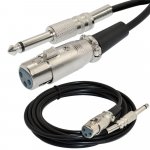
and one of these 1/4 TS To 1/8 Inch Mini TRS Mono Adaptor
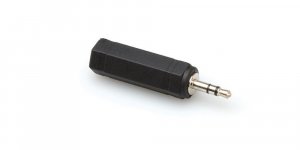
These will give you two channel recording of your single microphone.
If you are prepared to modify the connections within the 3.5mm plug, this is a better solution xlr female to 3.5mm stereo male cable
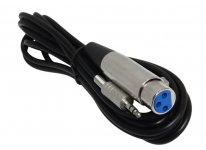
Dan.

and one of these 1/4 TS To 1/8 Inch Mini TRS Mono Adaptor

These will give you two channel recording of your single microphone.
If you are prepared to modify the connections within the 3.5mm plug, this is a better solution xlr female to 3.5mm stereo male cable

Dan.
Second thoughts, this is what you need
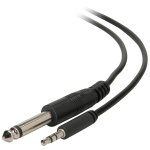
3.5mm Slim-Plug Stereo Male to 1/4" Mono Male Adapter Cable 6 ft.
Dan.

3.5mm Slim-Plug Stereo Male to 1/4" Mono Male Adapter Cable 6 ft.
Dan.
Max Headroom suggested plugging a mono-to-stereo adapter to the end of the TS cable using *this* adapter. But the problem with that is the description reads "It applies mono equally to stereo left and right" witch it the exact problem I currently have with my current setup! I want balanced. The unbalanced I have now is what I'm trying to fix. Or will that adapter actually give me balanced?
I found *this* product witch looks promising because it reads "Balanced audio cable" witch, to me, means that it will sound natural and not have to same signal doubled on both sides. Will this work?????
Also Max Headroom suggested *this* that reads "Carries a balanced signal from an XLR output to a 3.5mm input." Will that work too?? Again, I want balanced sound, and not unbalanced (same on both sides) which I am getting now.
I found *this* product witch looks promising because it reads "Balanced audio cable" witch, to me, means that it will sound natural and not have to same signal doubled on both sides. Will this work?????
Also Max Headroom suggested *this* that reads "Carries a balanced signal from an XLR output to a 3.5mm input." Will that work too?? Again, I want balanced sound, and not unbalanced (same on both sides) which I am getting now.
Last edited:
You Can't Get Balanced Sound Into Your Camcorder!!!!! It takes L and R, not hot, cold, and ground!
You made it sound like the issue was you can't get audio in your cam on both L and R. We solved that issue for you many ways. Your mic is BALANCED. You don't have anything by the sound of it that can take balanced audio.
It's clear you do not understand what balanced audio is, you really need to so that you can explain what you need done correctly so we can help you.
You made it sound like the issue was you can't get audio in your cam on both L and R. We solved that issue for you many ways. Your mic is BALANCED. You don't have anything by the sound of it that can take balanced audio.
It's clear you do not understand what balanced audio is, you really need to so that you can explain what you need done correctly so we can help you.
Last edited:
Your use of the word balanced is confusing matters as it has a fairly presise meaning in audio and it does NOT mean what you think it does.
What you want is the same signal on tip and ring, what you have gives opposite signals on tip and ring (That whole equal and opposite thing is what BALANCED means in audio, it has to do with a trick to improve interference suppression), it does NOT mean 'the same in both channels or anything like that.....
What you are calling 'balanced', the audio world calls 'Dual Mono'.
The wiring is utterly trivial, but I am racking my brains to see an obvious clean way to get there with off the shelf adaptors.
XLR Pin 1 & 3 -> 3.5mm TRS jack sleeve.
XLR pin 2 -> 3.5mm TRS jack tip AND ring.
Knocking this up is about 10 minutes work for anyone with a soldering iron, a female XLR, a 3.5mm TRS jack plug and a few feet of screened cable.
About the best I can come up with for off the shelf adaptors goes something like this:
XLR->TS(Mono) Jack lead -> Phono (Adaptor) -> Phono Splitter (adaptor) -> 3.5mm 'stereo' TRS jack lead (You might need a phono turnaround adaptor in there somewhere as well), sure it would work, but I shudder at the potential reliability issues. Far better to find someone local to solder up the appropriate cable if you are really determined to be utterly helpless about some noddy diy.
Regards, Dan.
What you want is the same signal on tip and ring, what you have gives opposite signals on tip and ring (That whole equal and opposite thing is what BALANCED means in audio, it has to do with a trick to improve interference suppression), it does NOT mean 'the same in both channels or anything like that.....
What you are calling 'balanced', the audio world calls 'Dual Mono'.
The wiring is utterly trivial, but I am racking my brains to see an obvious clean way to get there with off the shelf adaptors.
XLR Pin 1 & 3 -> 3.5mm TRS jack sleeve.
XLR pin 2 -> 3.5mm TRS jack tip AND ring.
Knocking this up is about 10 minutes work for anyone with a soldering iron, a female XLR, a 3.5mm TRS jack plug and a few feet of screened cable.
About the best I can come up with for off the shelf adaptors goes something like this:
XLR->TS(Mono) Jack lead -> Phono (Adaptor) -> Phono Splitter (adaptor) -> 3.5mm 'stereo' TRS jack lead (You might need a phono turnaround adaptor in there somewhere as well), sure it would work, but I shudder at the potential reliability issues. Far better to find someone local to solder up the appropriate cable if you are really determined to be utterly helpless about some noddy diy.
Regards, Dan.
- Status
- Not open for further replies.
- Home
- General Interest
- Everything Else
- How do I get balanced audio out of a standard XLR mic?

